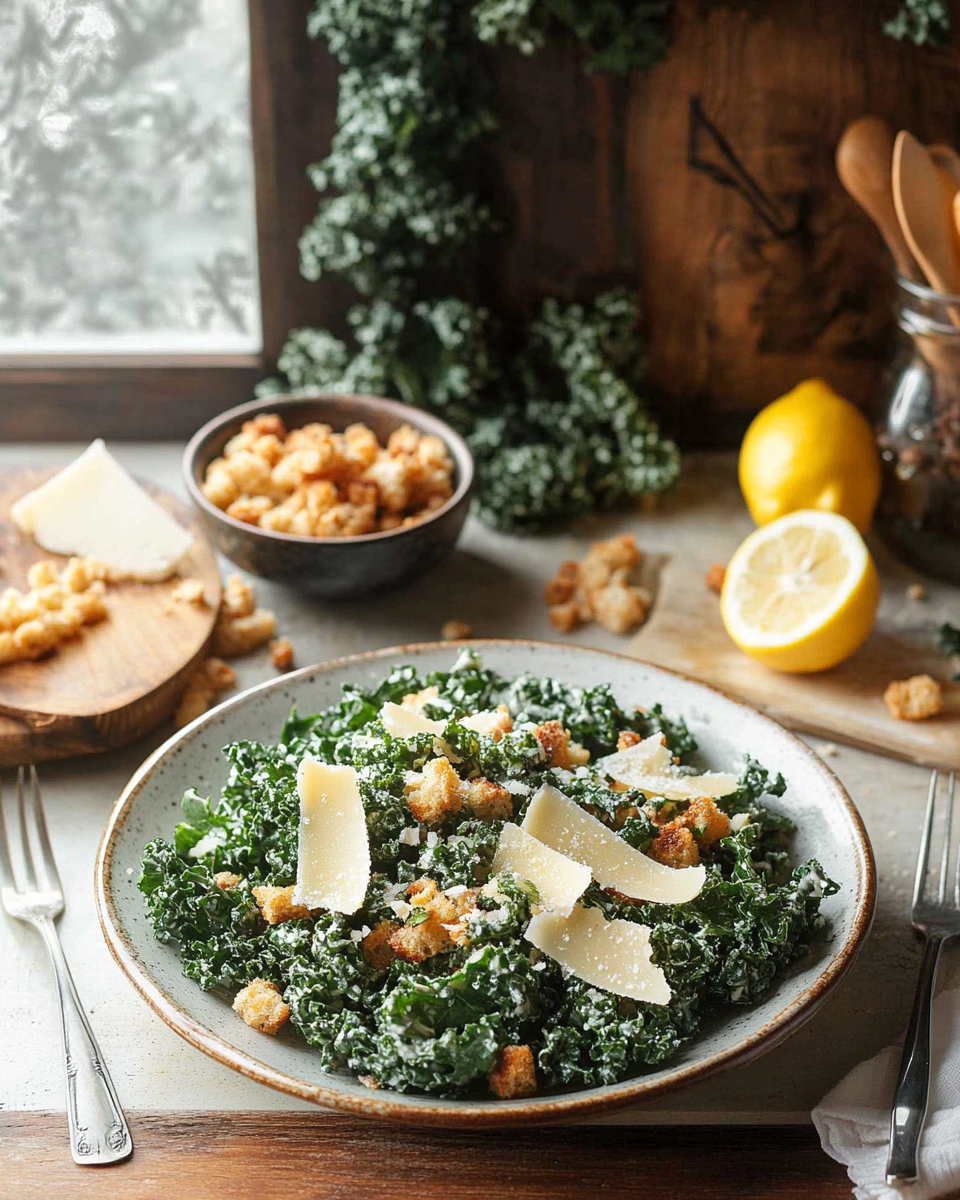A fresh and flavorful twist on the classic Caesar, this kale version is hearty, tangy, and packed with nutrients. The lemon-Parmesan dressing adds a bright and creamy punch that balances beautifully with the bitterness of kale. Perfect as a standalone meal or a side dish.
FULL RECIPE
Ingredients
- 1 large bunch of kale, stems removed and leaves chopped
- 1/2 cup grated Parmesan cheese
- 1 cup croutons (store-bought or homemade)
- 1 garlic clove, minced
- 1/4 cup freshly squeezed lemon juice (about 2 lemons)
- 1 tablespoon Dijon mustard
- 1 teaspoon Worcestershire sauce
- 1/2 cup extra-virgin olive oil
- Salt and black pepper, to taste
Directions
- Wash and thoroughly dry the kale, then place in a large salad bowl.
- In a small bowl, whisk together the lemon juice, Dijon mustard, minced garlic, Worcestershire sauce, and a pinch of salt and pepper.
- Slowly drizzle in the olive oil while whisking continuously to create a smooth emulsion.
- Add the Parmesan cheese to the dressing and stir to combine.
- Pour the dressing over the kale and massage it into the leaves for about 1–2 minutes until the kale is tender.
- Toss in the croutons and mix well.
- Top with additional Parmesan and a few cracks of black pepper, if desired. Serve immediately.
Nutritional Information
- Calories: 280
- Total Fat: 24g
- Saturated Fat: 5g
- Cholesterol: 10mg
- Sodium: 390mg
- Total Carbohydrates: 12g
- Dietary Fiber: 3g
- Sugars: 1g
- Protein: 6g
- Vitamin A: 150% DV
- Vitamin C: 90% DV
- Calcium: 20% DV
- Iron: 10% DV
Health Benefits of Kale in Caesar Salad
Kale is often dubbed a superfood because of its rich nutrient profile. It’s packed with vitamins A, C, and K, as well as antioxidants and fiber. Including kale in a Caesar salad not only boosts the dish’s flavor but significantly enhances its nutritional value. Kale’s fiber content supports digestion and helps maintain healthy cholesterol levels, while antioxidants fight inflammation and oxidative stress. This makes the kale Caesar salad a powerful choice for anyone looking to eat healthily without sacrificing taste.
Why Use Lemon in the Dressing?
Lemon juice in the dressing adds a refreshing, zesty brightness that balances the creamy and salty flavors of Parmesan and olive oil. It also acts as a natural tenderizer, helping to soften the tough kale leaves when massaged into the salad. The acidity of lemon juice helps to wake up the palate, making each bite feel lighter and more vibrant. Additionally, lemon juice is rich in vitamin C, which supports immune function and enhances iron absorption from the kale.
The Role of Parmesan Cheese
Parmesan cheese is a traditional ingredient in Caesar salad and contributes a distinct umami flavor. Its nutty, salty characteristics complement the bitterness of kale, creating a harmonious taste profile. Parmesan is also a good source of protein and calcium, adding to the salad’s nutritional benefits. Using freshly grated Parmesan rather than pre-grated ensures a better texture and more robust flavor.
Importance of Olive Oil
Extra-virgin olive oil is a cornerstone of the dressing, providing healthy monounsaturated fats that support heart health. It acts as a carrier for the other dressing ingredients, helping to blend flavors smoothly. Olive oil also adds a rich, velvety mouthfeel to the salad. Its antioxidants contribute to anti-inflammatory benefits, which pairs well with the kale’s health properties.
The Magic of Massaging Kale
Raw kale can be tough and fibrous, which sometimes makes it less enjoyable in salads. Massaging the kale with the dressing breaks down its tough fibers and softens the leaves, making them easier to chew and digest. This simple step transforms kale from a bitter, stiff green into a tender, flavorful base that absorbs the dressing beautifully.
Croutons: Adding Texture and Flavor
Croutons bring a satisfying crunch to the salad, creating a contrast to the soft, massaged kale leaves. They also add a toasty, buttery flavor that rounds out the dish. Using homemade croutons allows you to control the seasoning and oil used, making the salad even more delicious and personalized. For a healthier alternative, you can opt for whole-grain or gluten-free croutons.
Worcestershire Sauce: The Secret Ingredient
Adding Worcestershire sauce to the dressing introduces subtle depth and complexity. Its tangy, savory notes enhance the umami flavors of Parmesan and garlic, making the dressing taste richer. Although it’s a small addition, Worcestershire sauce helps tie together the dressing’s flavors, making the salad more well-rounded.
Customization Ideas
This kale Caesar salad is versatile and easy to customize according to your taste or dietary preferences. You can add grilled chicken or shrimp for a protein boost, or sprinkle toasted nuts and seeds for extra crunch and nutrients. For a vegan version, swap Parmesan with nutritional yeast and use vegan Worcestershire sauce. Experimenting with different herbs or adding a dash of hot sauce can also bring unique twists to the classic recipe.
Serving Suggestions
Kale Caesar salad is perfect as a light lunch, a side dish for dinner, or a starter at a dinner party. It pairs beautifully with roasted meats, seafood, or grain-based dishes. Serving it chilled enhances its refreshing qualities, but it can also be enjoyed at room temperature. Adding a lemon wedge on the side allows guests to adjust the acidity to their liking.
Storage and Shelf Life
Because kale is hearty, this salad tends to hold up well if stored properly. Keep leftovers in an airtight container in the refrigerator for up to 2 days. However, croutons are best added just before serving to avoid sogginess. If you plan to store it longer, keep the dressing separate and toss the salad just before eating to maintain freshness and texture.
Environmental and Seasonal Benefits
Kale is a cool-season crop that thrives in fall and winter, making this salad a great option during those months. It’s widely available year-round in many places, and often grown organically or locally, which supports sustainable farming practices. Using seasonal kale ensures you get the freshest, most nutrient-dense greens while reducing environmental impact.
Comparing Kale Caesar Salad to Traditional Caesar Salad
Unlike the classic Caesar salad made with romaine lettuce, the kale version offers more fiber and nutrients but with a slightly earthier, more robust flavor. Romaine is crisp and mild, while kale has a firmer texture and stronger taste. This makes kale Caesar salad a great alternative for those wanting a more substantial and healthful salad that still honors the original’s bold flavors.
Conclusion
The Kale Caesar Salad with Lemon-Parmesan Dressing is much more than just a tasty dish—it’s a nutrient-rich meal that supports wellness without compromising flavor. Its combination of hearty kale, tangy lemon, savory Parmesan, and crunchy croutons offers a delightful balance of texture and taste. The dressing’s bright, creamy character enhances the greens while the simple preparation makes it accessible for cooks of all levels. Whether you’re looking to eat healthier, add variety to your meals, or impress guests with a modern take on a classic, this salad delivers on all fronts. Incorporating this recipe into your routine can elevate your salad game and nourish your body with every bite.






